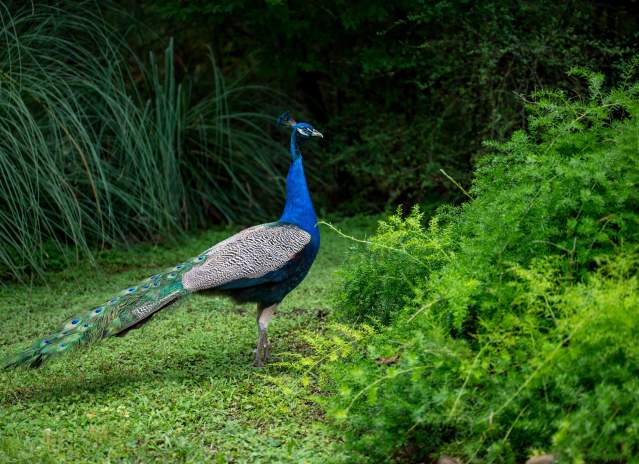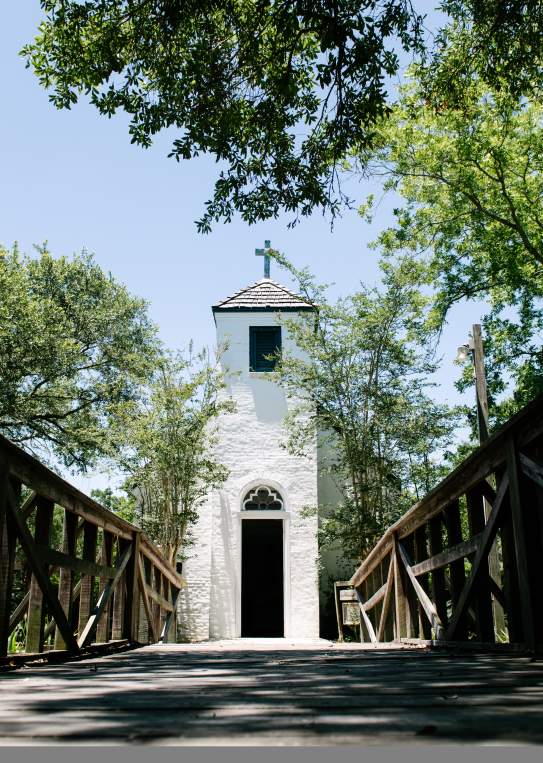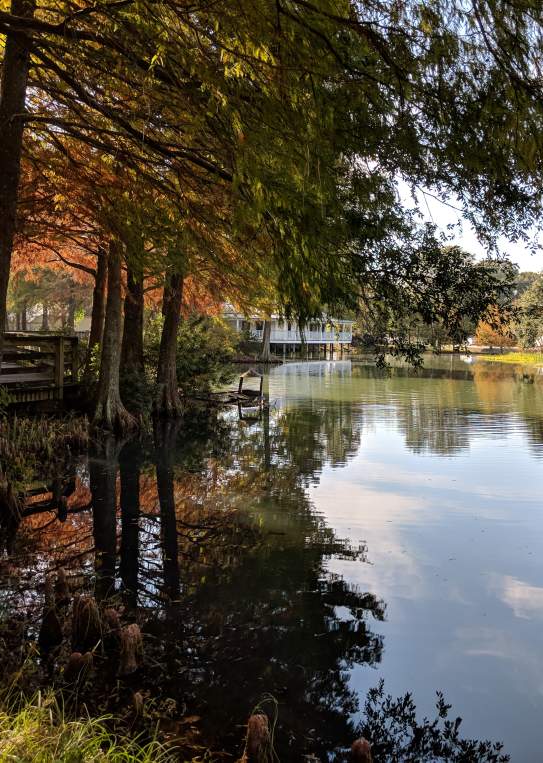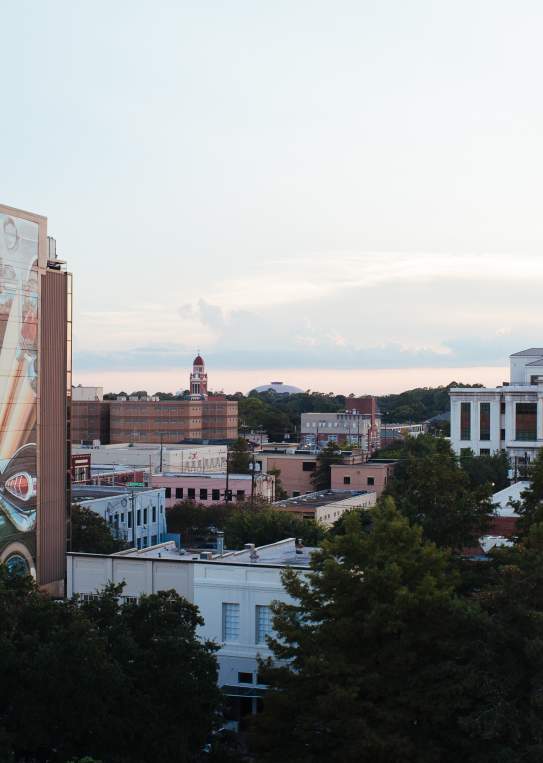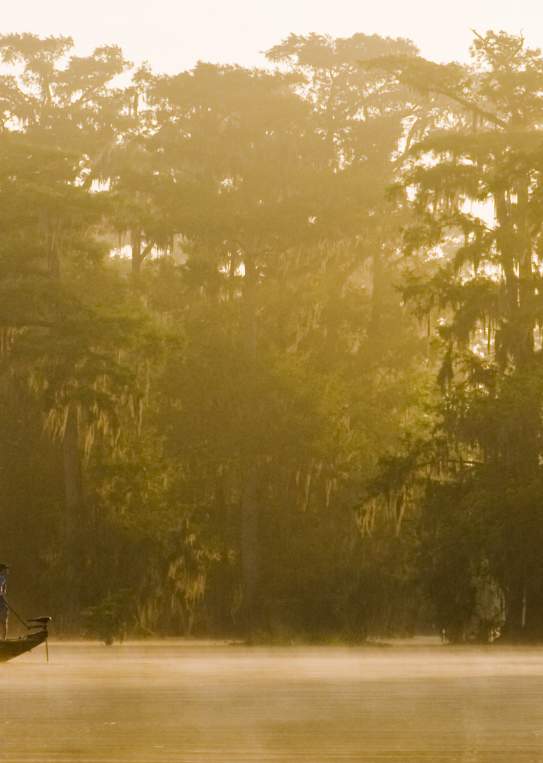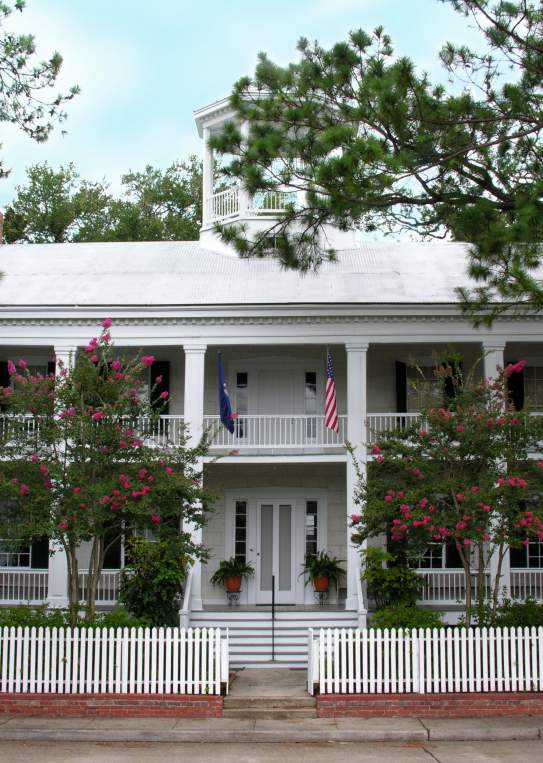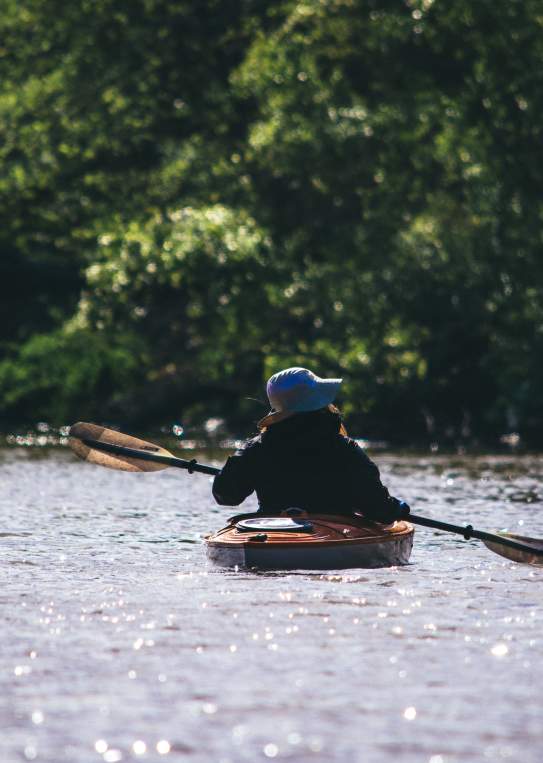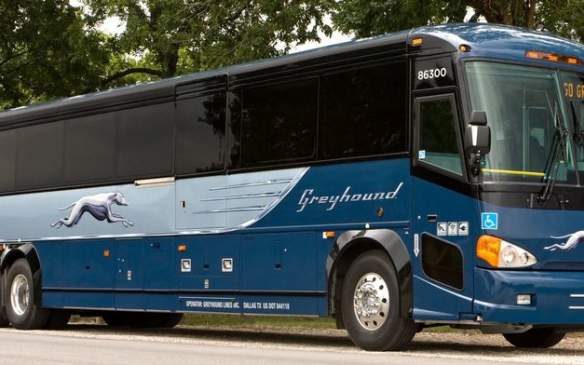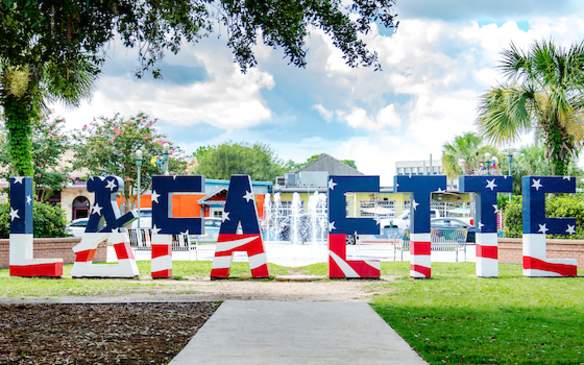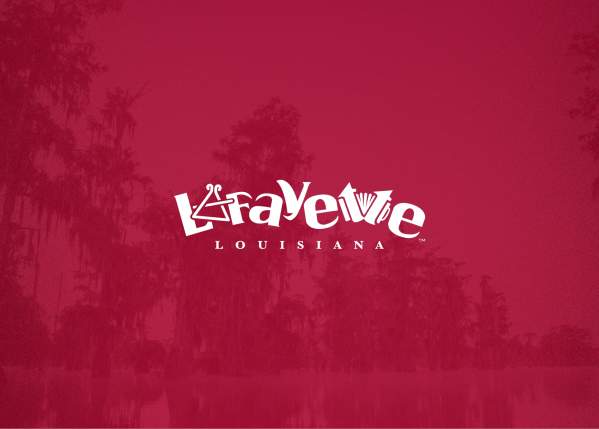Your browser is not supported for this experience.
We recommend using Chrome, Firefox, Edge, or Safari.
Acadiana by Parish
Acadiana, or The Heart of Acadiana is the official name given to the French Louisiana region that is home to a large Francophone population. Many are of Acadian descent and are now identified as Cajun. Of the 64 parishes that make up the U.S. state of Louisiana, 22 named parishes and other parishes of similar cultural environment make up this intrastate region.
Acadia Parish

Map of Lafayette Parish, Louisiana With Municipal Labels
Named for the original French-Canadian provincial home of the Acadian exiles, Acadia Parish is the heart of Cajun prairie country. Dotted with rice fields and mills, Crowley, the parish seat, is nicknamed the “Rice Capital of America.” Its historic, Art Deco-style Rice Theatre presents monthly music events. The humble frog put the town of Rayne on the map back in the 1880s, when entrepreneurs began exporting frog legs to restaurants nationwide. Today, many frog-themed murals promote Rayne as the “Frog Capital of the World.” Not to be outdone, the nearby community of Church Point has called itself the “Buggy Capital of the World” since the 1920s, after the mode of transportation residents took to attend Sunday services at the area’s only church (the annual Buggy Festival occurs the first weekend of June). Each year, on the Sunday before Fat Tuesday, a traditional Courir de Mardi Gras features masked and costumed celebrants on horseback. The home parish of many Cajun musicians, Acadia birthed the first ever recorded Cajun artists, Joseph Falcon and his wife, Cléoma Breaux; early recording stars the Breaux Brothers, Amédé, Ophey, and Aldus; swamp pop star Johnnie Allan; and accordionist Jo-El Sonnier.
Evangeline Parish
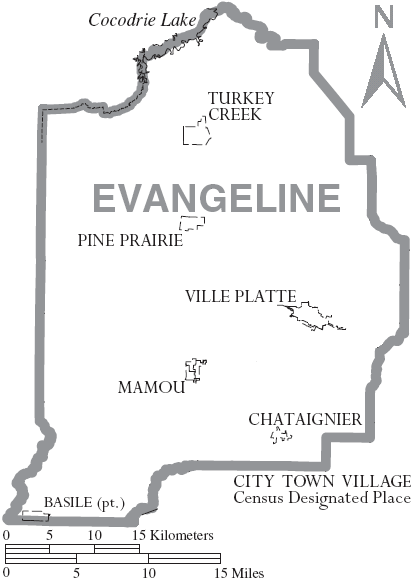
Map of Evangeline Parish, with municipal labels
The mythic Acadian girl made famous by Henry Wadsworth Longfellow’s epic 1847 poem gives this parish its name. The largest city and parish seat, Ville Platte, or “flat city,” is named for the area’s relatively horizontal topography. Popular legend holds that the city was founded by Marcellin Garand, a French major in the Napoleonic Army. Today, Ville Platte is known as both the “Smoked Meat Capital of the World” (celebrated in an annual June festival) and the “Swamp Pop Capital of the World” (memorialized at a local museum). The town of Mamou is home to Fred’s Lounge, a 70-plus-year-old bar and Cajun dance hall only open on Saturday mornings. Arrive early; it fills up quick. On Mardi Gras morning, costumed revelers go door-to-door collecting ingredients for a gumbo to feed the whole town during the famed Courir de Mardi Gras. The town of Basile houses the Nathan Abshire Museum, celebrating the life and career of the man who helped popularize Cajun music beginning in the 1940s. Evangeline Parish is also home to Chicot State Park, a man-made lake surrounded by rolling hills.
Iberia Parish

Map of Iberia Parish, with municipal labels
Louisiana’s leading sugar-producing parish—home to three of the state’s eleven operational sugar mills—Iberia is named for the Iberian Peninsula and the Spanish people that settled the area. Located on the Bayou Teche, the parish seat of New Iberia is one of Acadiana’s leading economic and cultural outposts. It is the birthplace of artist George Rodrigue and the home of James Lee Burke’s fictional detective Dave Robicheaux. A top local travel destination, New Iberia hosts a variety of annual celebrations, including the Louisiana Sugar Cane Festival, the World Championship Gumbo Cook-Off, the Delcambre Shrimp Festival, Books Along the Teche Literary Festival, and El Festival Español de Nueva Iberia. Nearby, the salt dome of Avery Island has been the home of the McIlhenny family’s Tabasco brand hot sauce since 1868. Avery Island also houses a botanical preserve and bird sanctuary known as Jungle Gardens. History and architecture lovers can visit Shadows-on-the-Teche (a National Trust plantation home and garden), Bayou Teche Museum, and the Conrad Rice Mill and Konriko Company Store (the oldest operating rice mill in America); or take self-guided tours of the New Iberia National Register Historic District and James Lee Burke’s Iberia. Jefferson Island Rip Van Winkle Gardens provides a peaceful garden escape with Asian statues on the banks of Lake Peigneur, tasty Cajun and Creole specialties at Café Jefferson, bird watching at Rip’s Rookery, and well-appointed bed and breakfast cottages. The town of Jeanerette, a sugar capital, once known as “Sugar City,” is home to LeJeune's Bakery, one of the nation’s oldest surviving bakeries (since 1884), and popular purveyor of French bread and ginger cakes. The parish’s southernmost boundary stretches into the Gulf of Mexico, incorporating Marsh Island, a wild bird refuge and offshore fishing destination.
Jefferson Davis Parish

Map of Jefferson Davis Parish, with municipal labels
Named for the President of the Confederate States of America, Jefferson Davis Parish is a largely rural region of Acadiana located along Interstate 10 between Lafayette and Houston. Jennings, the parish seat, was a railroad depot-turned-petroleum boom town after Louisiana’s first oil well was unearthed nearby. The most popular attraction today is the Gator Chateau, or Alligator House, a fostering facility for adult alligators, as well as babies that can be held. The town of Lake Arthur surrounds a freshwater lake peppered with cypress trees and, on its north shore, ringed by a white sand beach. In Lacassine, the Bayou Rum Distillery offers tours of their factory where each batch is brewed from 100% Louisiana sugarcane. The Lacassine National Wildlife Refuge, nearly 35,000-acres, is one of the nation’s top migratory wildfowl wintering sanctuaries, a perfect place for bird spotting and sport fishing.
Lafayette Parish
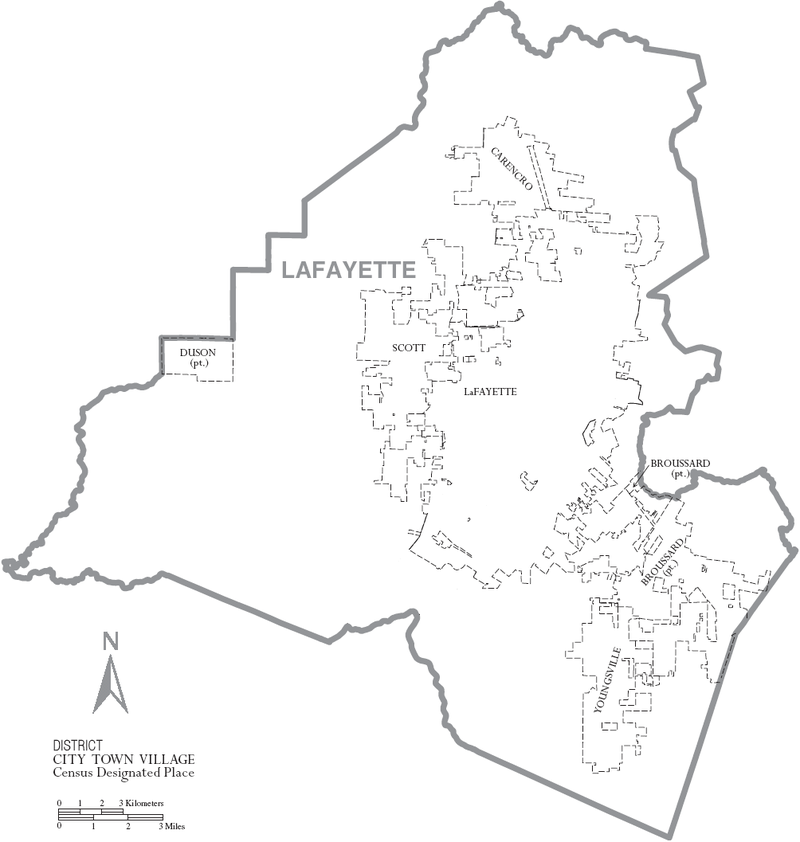
Map of Lafayette Parish, Louisiana With Municipal Labels
The hub of Acadiana, the heart of Cajun and Creole country, Lafayette Parish is named for the Marquis de Lafayette, the French hero of the American Revolutionary War. The parish’s largest city and seat of government are Lafayette, called Vermilionville from 1821 to 1884, and is known as the Happiest City in America after a national survey proclaimed it such. A bustling city with a wealth of shopping and dining options, Lafayette hosts a food or music festival nearly every weekend of the year, including the Festival International de Louisiane in April, the Festivals Acadiens et Créoles in October, and the state’s second-largest Mardi Gras celebration. The Vermilionville Historic Village offers a fun and informative look at colonial life, while the Acadian Cultural Center features special exhibits and ranger-guided boat tours of the Bayou Vermilion. The Hilliard University Art Museum and the Acadiana Center for the Arts host a rotating schedule of art exhibits and concerts featuring local and national acts. In the nearby town of Scott, the “Boudin Capital of the World,” the pork and rice-stuffed sausage is everybody’s favorite meal.
St. Landry Parish
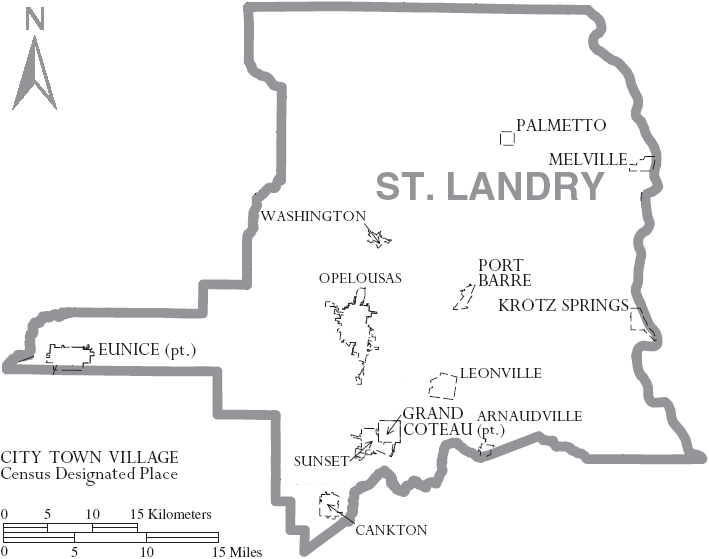
Map of St. Landry Parish, Louisiana With Municipal Labels
St. Landry Parish was once the domain of the indigenous Appalousa people, who gave their name to the parish seat of Opelousas. Today Opelousas, likely Louisiana’s third-oldest city, and its capital during the Civil War, is known as the “Zydeco Music Capital of the World.” Zydeco King Clifton Chenier was born here, as were two distinguished chefs who brought Cajun cuisine to the world: Paul Prudhomme and Tony Chachere. St. Landry’s second largest town, Eunice, bills itself as the Prairie Cajun Capital, where rice fields and crawfish ponds stretch into the horizon. Eunice is the site of several important music locales, including the Savoy Music Center, an accordion atelier with a Cajun jam every Saturday morning; the Liberty Theatre’s Rendez-vous des Cajuns live radio show; and Acadiana’s premier all-local radio station, KBON 101.1. The little town of Arnaudville is home to Bayou Teche craft brewery and the always fascinating NUNU Arts & Culture Collective, a gallery, gift shop, and communal gathering spot. Once a bustling steamboat town, Washington now houses the Old Schoolhouse Antique Mall, 40,000 square feet of vintage collectables. And don’t forget to pass by Port Barre, where the headwaters of the Bayou Teche begin, and the annual Cracklin Festival gets eaters crunching on fried pig skins.
St. Martin Parish
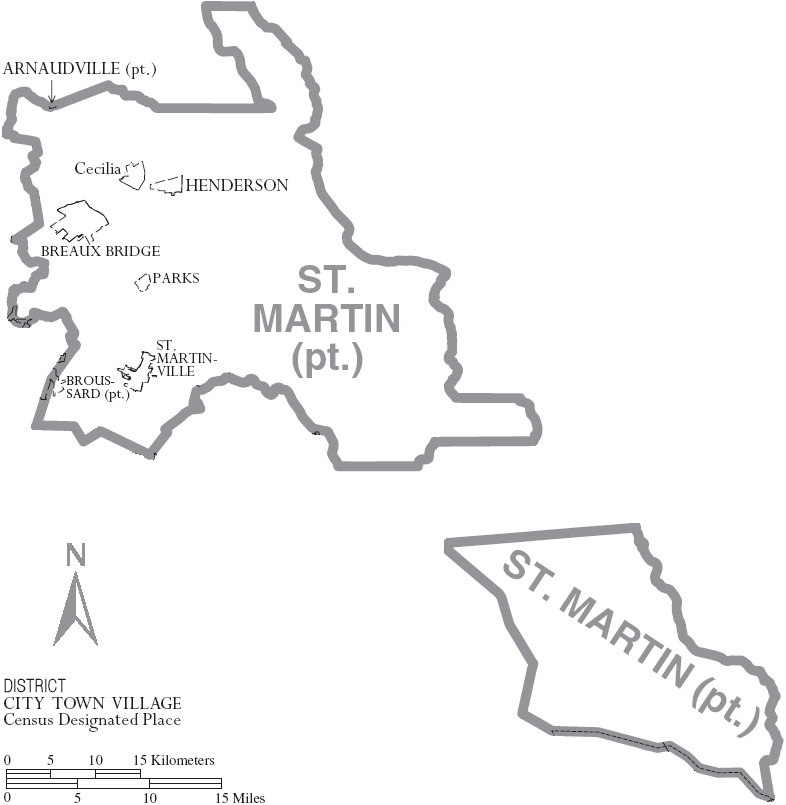
Map of St. Martin Parish, Louisiana With Municipal Labels
Once known as the Attakapas Parish, after the indigenous people who called this place home, St. Martin Parish was founded in 1811, a half-century after Acadian exiles, originally from Nova Scotia, began settling the region. Located on the Bayou Teche, St. Martinville, the parish seat and one of Louisiana’s oldest towns, is generally considered the birthplace of Cajun culture. Founded in 1765 by exiled French-Canadians, St. Martin de Tours Catholic Church dominates the downtown square. Nearby stands the Museum of the Acadian Memorial, home of the Wall of Names of 3,000 Acadian refugees; the African American Museum; and the Evangeline Oak, once one of the most photographed trees in the world. Just up the Bayou Teche, in Breaux Bridge, the “Crawfish Capital of the World,” locals and tourists fill downtown’s antique stores, Cajun restaurants, and dance floors. Situated on the Atchafalaya Basin levee, the town of Henderson offers freshwater fishing (bass and sac-au-lait reign supreme) and plenty of Cajun cooking. Located close to Breaux Bridge, Lake Martin is one of the area’s best nature stops. Walk along the boardwalk or rent a kayak and paddle around this wildlife preserve, waterfowl rookery, and cypress-and alligator-filled swamp.
St. Mary Parish

Map of St. Mary Parish, Louisiana With Municipal Labels
Known as the “Cajun Coast,” over half of St. Mary Parish is covered in water. There’s beautiful Cypremort Point State Park, which offers man-made beaches, fishing, and sailboating. The Bayou Teche ends its 125-mile journey to merge with the Lower Atchafalaya River near the town of Patterson—the lower section that winds through the parish is well worth a drive down the Bayou Teche Scenic Byway. The Bayou Teche National Wildlife Refuge merges 9,028 acres of protected cypress-tupelo swamps, hardwood forests, and freshwater marshes offer a plethora of paddling trails and serve as the primary sanctuary for the Louisiana black bear, the state’s official mammal. The historic district of Franklin, the parish seat and a former sugar boom town, is perfect for a stroll beneath the moss-covered oaks and cast iron street lamps—over 420 buildings are listed on the National Register of Historic Places. In Morgan City, the parish’s largest town, the International Petroleum Museum and Exposition is the only place in the world where visitors can experience life aboard an authentic offshore oil rig. The Native American Chitimacha Tribe (often translated as the “people of the many waters”) makes their home at a bend in the Bayou Teche near Charenton—their famed weaved baskets are on display at the Chitimacha Museum.
Vermilion Parish

Map of Vermilion Parish, Louisiana With Municipal Labels
Vermilion Parish, named for the river and bay central to Acadiana’s identity, officially bills itself as the “Most Cajun Place on Earth.” The vast historic town square of Abbeville, the parish seat, is perfect for a stroll beneath the oaks, a peek at the giant “cans” outside the Steen’s Cane Syrup mill, and a visit to Black’s Oyster Bar, established in 1967. Save room for the town’s Giant Omelette Celebration, held each November, and featuring a 5,000 egg omelette prepared by a contingent of chefs hailing from around the world. Just east in Delcambre, the annual August Shrimp Festival is one of Louisiana’s foremost culinary celebrations; expect shrimp cook-offs, fais-do-do dancing, and the all-important blessing of the fleet. West of Abbeville is Kaplan, the “Gateway to the Wetlands,” entry to points further south down Highway 82, including hunting and fishing meccas like Cow Island, Forked Island, and Pecan Island. Further south along the route, and beyond the marshlands into the Gulf of Mexico, offers plenty of opportunities for spotting wildfowl, alligator, deer, and nutria.
Inspiration Journal
Lafayette's blog showcasing the food, music, culture and history at the heart of Cajun & Creole Country.
See All PostsLafayette Weekly
A weekly curated playlist by local musician Philippe Billeaudeaux featuring music by Lafayette, LA musicians with a weekly rundown of live music happening in and around the area…
Group Dining in Lafayette
Lafayette is known for its rich culinary scene, from Cajun flavors to fine dining and family-friendly spots that cater to every occasion. Whether you're traveling with a large…
Lafayette Pet Friendly Guide
Traveling with your furry friend? You’re in luck—Lafayette is a great place to explore with pets in tow! From dog-friendly patios and spacious parks to pet-friendly…
April Events Spotlight
If you want to spend time in the Hub City and know what events are happening, you're in the right place. We'll give you a rundown of live music and other monthly events…
Getting to Lafayette
The city of Lafayette, LA is located in the center of Lafayette Parish at the intersection of I-10 and I-49 between New Orleans and Houston and only 35 miles north of the Gulf of Mexico.
